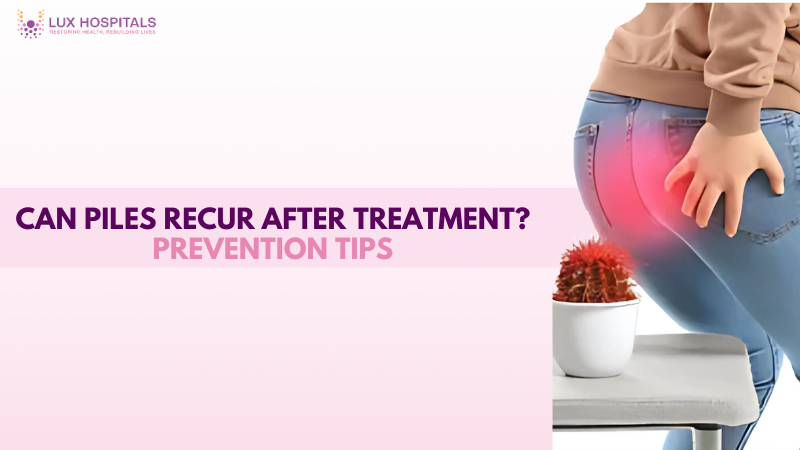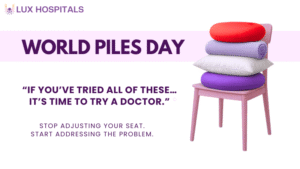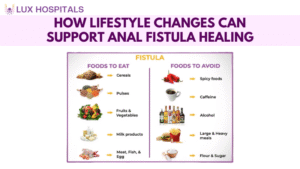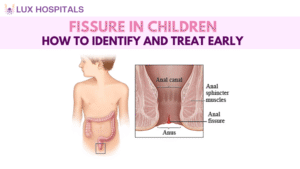Do Piles Come Back After Treatment? How to Prevent Recurrence

Do piles come back after treatment? is one of the most frequent topics that patients ask about. Even while medical treatment reduces pain, swelling, and bleeding, if the underlying causes are not addressed, Piles recurrence may occur. Piles form when the veins around the rectum or anus swell, usually due to straining, constipation, or prolonged sitting. This blog explains why Piles may return, the risk factors, and effective prevention strategies to avoid Piles recurrence in the long run.
Do Piles Come Back After Treatment?
Yes, following treatment, a piles may reappear in many circumstances. Although medical procedures can reduce or remove enlarged veins, they cannot completely prevent the formation of new ones. Piles Recurrence is very possible if the patient keeps up their bad eating habits, inactivity, or bowel habits. For this reason, long-term lifestyle modifications are just as important as medical care.
Why Do Piles Recur After Treatment?
There are several reasons why a Piles may recur:
- Persistent constipation: If stools remain hard and bowel movements involve straining, pressure builds on the rectal veins.
- Sedentary lifestyle: Sitting for long periods restricts blood flow, making veins weaker.
- Obesity or pregnancy: Extra pressure on the pelvic area contributes to Piles recurrence.
- Incomplete treatment: Small piles that remain untreated can grow and cause symptoms again.
Unless these risk factors are controlled, Piles recurrence becomes unavoidable.
Risk Factors That Increase Piles Recurrence
Some people are more prone to Piles after treatment due to specific risk factors:
- Family history: Weak blood vessels can run in families.
- Age: With aging, rectal tissues lose elasticity, increasing vulnerability.
- Chronic diarrhea: Frequent irritation of the rectal area can also cause Piles recurrence.
- Low-fiber diet—Diets: high in refined foods lead to constipation.
- Dehydration: Hard stools are a result of not drinking enough water.
Recognizing these risk factors allows individuals to take early preventive steps.
Piles Recurrence After various Treatments
Treatment type affects the likelihood of a pile returning:
- Home remedies like sitz baths, ointments, and dietary adjustments provide temporary relief but do not cure piles fully.
- Minimally invasive techniques, including sclerotherapy, rubber band ligation, or infrared coagulation, are effective for mild to moderate piles. However, Piles recurrence may still occur if lifestyle changes are ignored.
- Surgical procedures like hemorrhoidectomy or stapling provide longer-lasting results, yet Piles recurrence is possible if the root causes persist.
This means no treatment guarantees a 100% permanent cure without preventive measures.
How Lifestyle Changes Prevent Piles Recurrence?
Adopting healthy lifestyle habits is the cornerstone of preventing Pile recurrence.
- Fiber-rich diet: Fiber softens stool and promotes regular bowel movements.
- Adequate hydration: Drinking 2–3 liters of water daily prevents constipation.
- Exercise: Exercise increases blood flow and lowers pelvic pressure.
- Healthy bowel habits: Avoid straining, and do not delay the urge to pass stool.
Following therapy, these minor adjustments greatly reduce the likelihood of Piles recurrence.
The Importance of Diet in Prevention
Diet is one of the best ways to lessen the likelihood that piles will recur. A diet high in fruits, vegetables, whole grains, and legumes will ensure softer stools. Irritation and constipation can be avoided by avoiding processed foods, red meat, fried foods, and too much coffee. Healthy digestion is also supported by eating meals on schedule and chewing food correctly.
Role of Physical Activity in Long-Term Prevention
Frequent exercise improves digestion in addition to improving circulation in the rectal area. Exercises including yoga, cycling, and brisk walking strengthen abdominal muscles and prevent constipation. On the other hand, a sedentary lifestyle puts constant pressure on the rectum, increasing the chances of piles returning. Daily moderate exercise of even 30 minutes can make a huge difference.
Medical Follow-Up and Monitoring
Even after successful treatment, patients should not ignore follow-up checkups. Doctors can assess whether a Piles is returning and recommend early interventions. Timely medical attention prevents minor issues from turning into painful, recurrent piles.
Long-Term Strategy to Avoid Piles Recurrence
For long-term prevention of Piles recurrence, a combination of medical care and lifestyle changes works best:
- Maintain regular bowel movements with fiber and water.
- Stay active and avoid prolonged sitting.
- Use a footstool while using the toilet to reduce strain.
- Keep weight under control and manage pregnancy-related risks.
- Seek medical advice at the first sign of Piles recurrence.
Maintaining these practices consistently guarantees long-lasting relief and a healthier digestive tract.
Conclusion
Even if medication relieves the condition, if precautions are not taken, a piles may return. Poor diet, constipation, obesity, and sedentary lifestyles are typically associated with the Piles recurrence of habits. However, with a fiber-rich diet, hydration, exercise, and healthy bowel practices, Piles recurrence can be minimized or even avoided. Taking charge of your lifestyle is the best way to keep Piles from troubling you again. By making mindful lifestyle changes and seeking timely medical guidance, you can significantly lower the risk of Piles recurrence and enjoy long-term relief from Piles
Frequently Asked Questions
Yes, even after surgery, piles may recur, particularly if the underlying causes—such as obesity and constipation—are not treated. Existing piles can be removed surgically, but new ones can still form. Preventive care is still crucial.
While some anecdotal reports suggest that fish oil, which contains anti-inflammatory omega-3 fatty acids, may help with piles, there’s currently no strong clinical research to confirm its effectiveness. As of now, fish oil cannot be recommended as a reliable treatment for piles.
Sitting for long hours, eating processed food, and not drinking enough water increase the risk. Ignoring the urge to pass stool and leading a sedentary life also contribute. These habits should be corrected to prevent recurrence.
Home remedies like sitz baths, topical creams, and dietary changes can provide relief, but are not always enough. They manage symptoms but do not eliminate the underlying cause. Long-term prevention requires medical care and lifestyle adjustments.
A sitz bath—sitting in warm water that covers the anal area—can help soothe symptoms of a Pile by reducing inflammation and relieving muscle tension around the rectum. This gentle remedy promotes increased blood flow and cleanliness, which aids healing and may prevent recurrence of the condition.




















